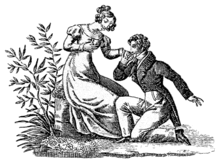Marriage proposal



A marriage proposal is an event where one person in a relationship asks for the other's hand in marriage.[1] If accepted, it marks the initiation of engagement, a mutual promise of later marriage. It often has a ritual quality.
Traditional proposals[]
In some Western cultures it is traditional for the man to make a proposal to the woman directly while genuflecting in front of her. The ritual often involves the formal asking of the question "Will you marry me, ...?" and the presentation of an engagement ring. It may include him putting the ring on her finger.
Other customs of initiating a marriage may include formal introduction of the partners to each other, such as the Japanese traditional custom of Miai.
In many cultures it is traditional for a man to ask permission from a woman's father, in private, before proposing to her, or if her father has already died and she is still young, to ask permission of a near relation of hers. In earlier times, parental consent was necessary, if the man wanted to receive a dowry or other money, and fathers could refuse proposals from men whom they considered unsuitable as husbands for their daughters.
Although it is uncommon in the West these days, the parents of the couple may make a marriage arrangement, preceding or superseding the proposal. Arranged marriages were common between members of royal families throughout most of European history; such marriage contracts and proposals were made at great distances and often without first-hand contact between the parties prior to the engagement.
Modern Western proposals[]
Although most potential couples discuss their willingness to marry for a significant amount of time before a proposal occurs, and may schedule a specific time and place for the proposal to be made, it can also be intended as a surprise, although a survey on a wedding planning website reported that most proposals were not surprises.[2]
Although some proposals have been filmed for social media, most wedding engagements now begin with a conversation in which the parties mutually agree to wed, rather than a staged event.[2]
Gender roles[]
In Scotland, Ireland and England, 29 February in a leap year is said to be the one day when a woman can propose to her partner. Finland has the same custom, with the addition that a man rejecting such a proposal was expected to buy his suitor enough cloth for a skirt as compensation.[3]
As a monarch, Queen Victoria had to propose to Prince Albert.[4] Proposals by women have become more common in the English-speaking world in recent years, so jewelry companies have manufactured engagement rings for men.[5] In the United States, about 5% of proposals are made by women. Younger people are less likely to approve of women proposing.[6]
References[]
| Wikimedia Commons has media related to Marriage proposals. |
- ^ Schlesinger, Herbert J. (2008), Promises, Oaths, and Vows: On the Psychology of Promising, CRC Press, pp. 18–19, ISBN 0203927354
- ^ Jump up to: a b Weiss, Suzannah (2020-11-18). "Forget the Fancy Proposal. Let's Just Get Married". The New York Times. ISSN 0362-4331. Retrieved 2020-11-23.
- ^ "Leap Year Proposal: What's The Story Behind It?". Huffingtonpost.com. 2012-02-29. Retrieved 2014-08-11.
- ^ "Queen Victoria - Victoria Proposes to Albert - Eminent Women of the Age". Womenshistory.about.com. 2014-03-14. Retrieved 2014-08-11.
- ^ "Australian news article about women proposing". Smh.com.au. 2004-02-29. Retrieved 2014-08-11.
- ^ "Why don't women propose to men?". CBS News. 2014-05-05.
Further reading[]
- Davis, Ernest, ed. (2020). "Will You Marry Me?" Some First-Hand Accounts of Marriage Proposals, 1600-1900 (PDF).
- Engagement
- Proposals
